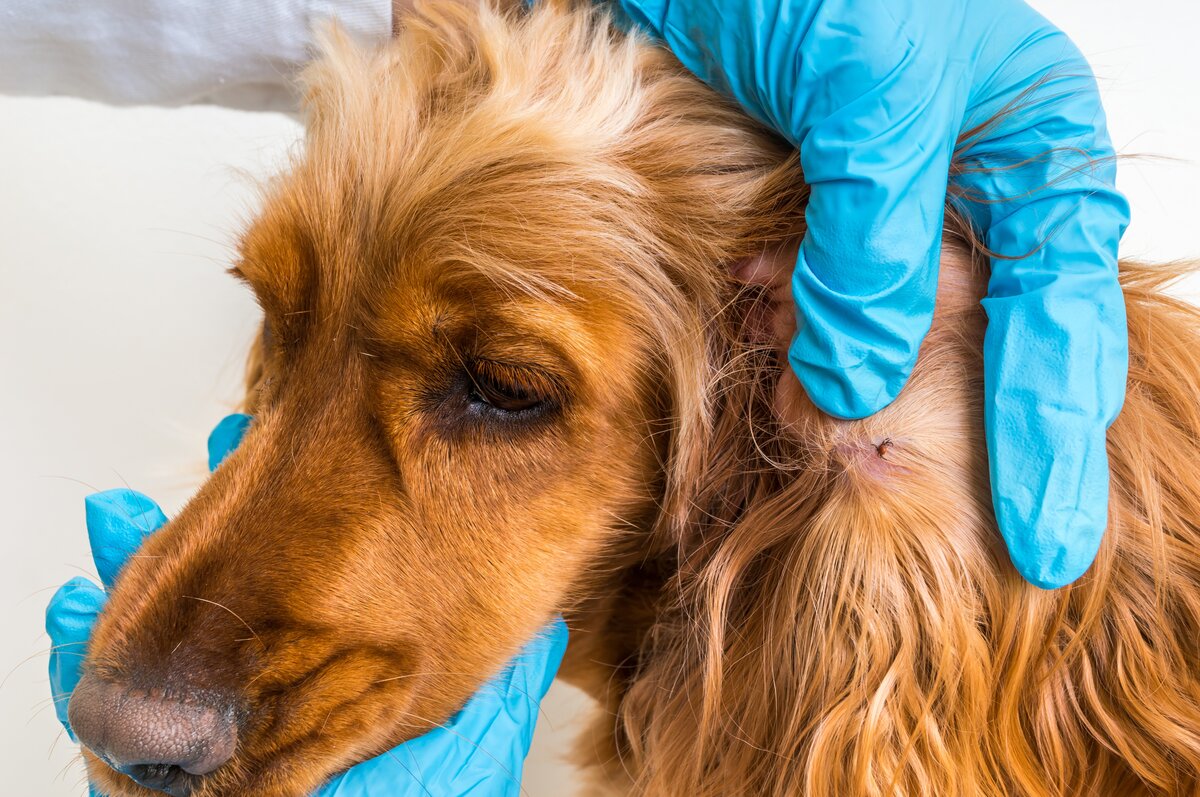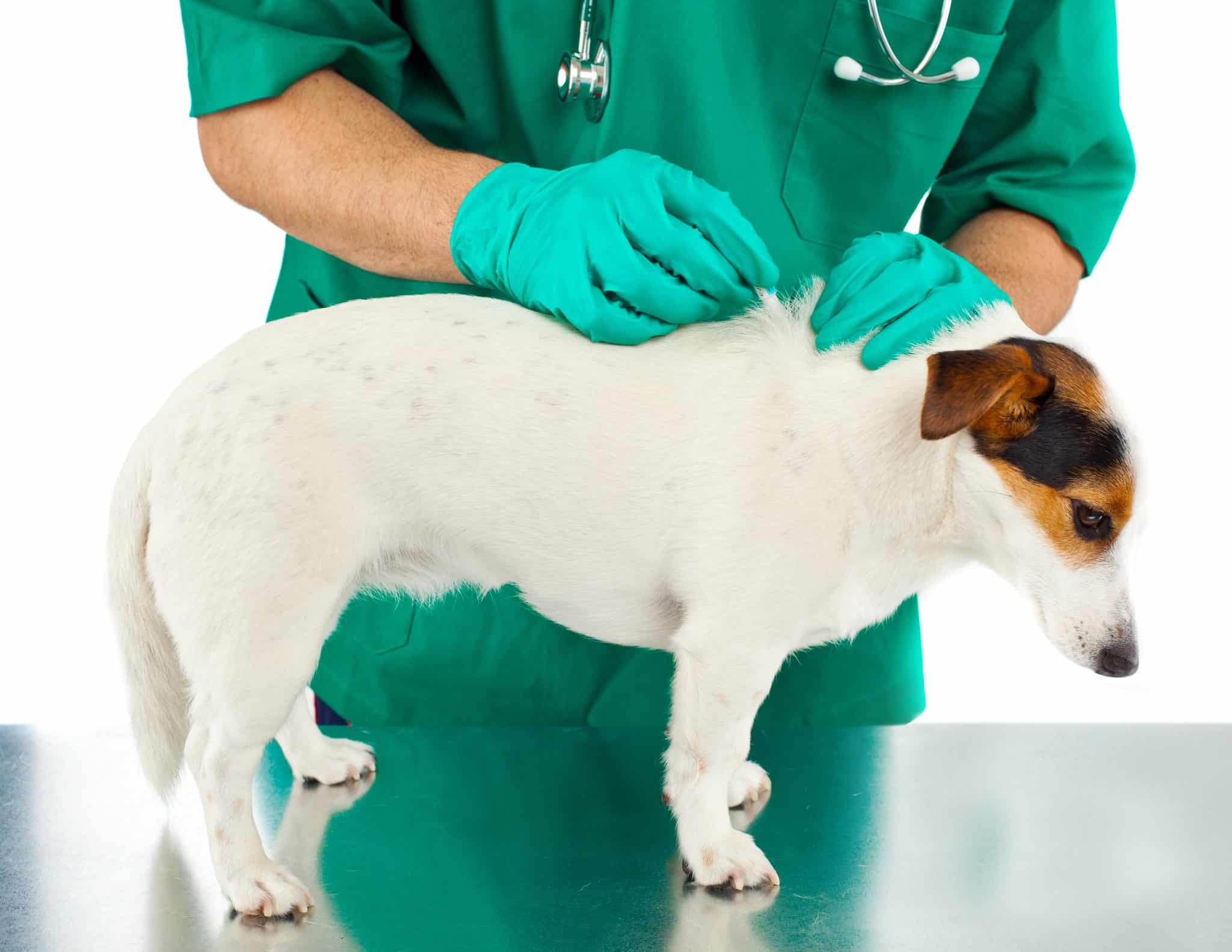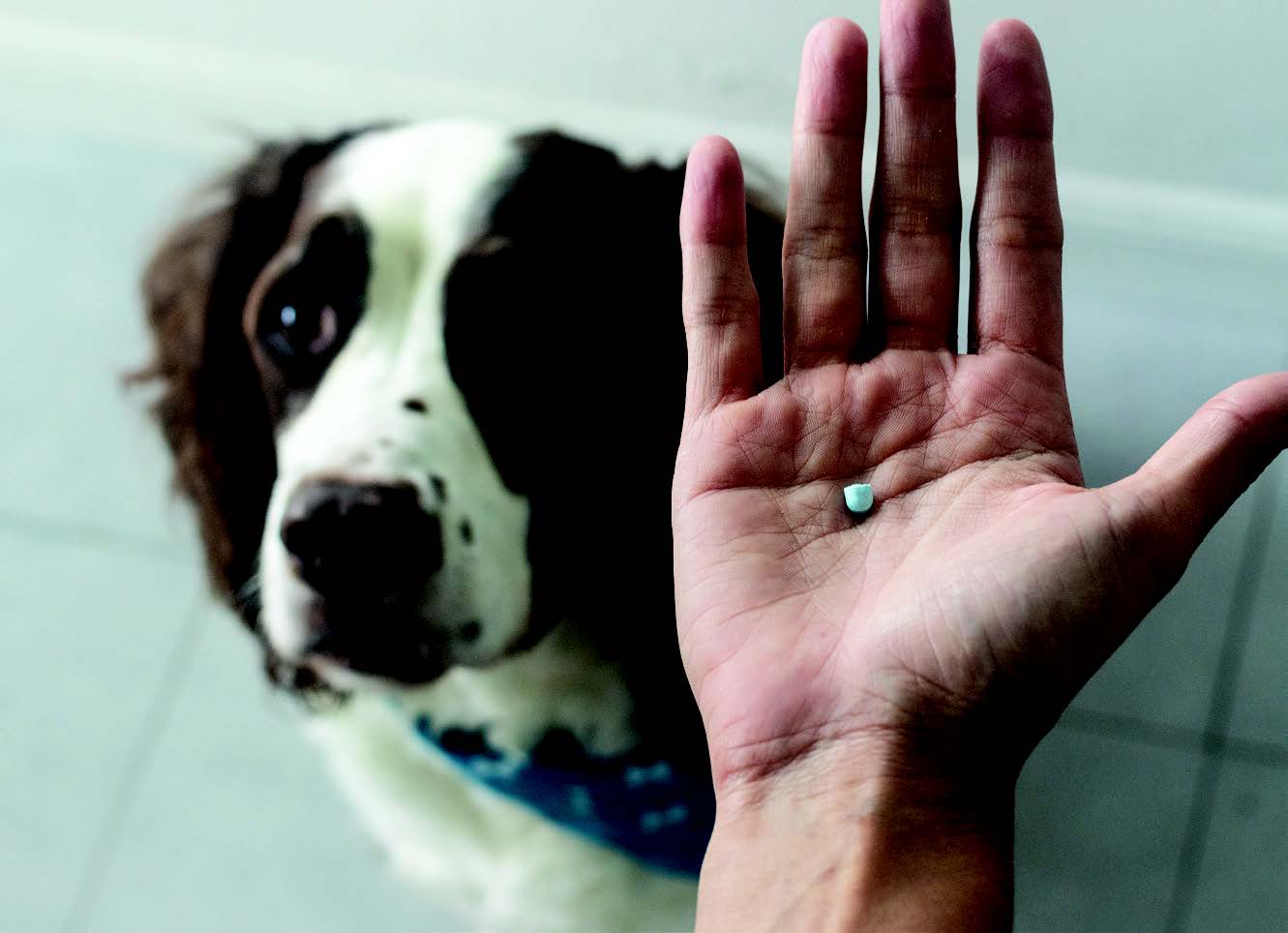Home>Health & Wellness>Common Health Issues>What Happens If A Tick Bites A Dog


Common Health Issues
What Happens If A Tick Bites A Dog
Published: February 3, 2024
Learn about common health issues in dogs caused by tick bites and how to prevent and treat them. Keep your furry friend safe and healthy with these tips.
(Many of the links in this article redirect to a specific reviewed product. Your purchase of these products through affiliate links helps to generate commission for Pawsomeoldies.com, at no extra cost. Learn more)
Table of Contents
Introduction
Ticks are tiny, blood-sucking parasites that can pose a significant threat to the health of our furry companions. When a tick bites a dog, it can lead to various health issues, making it crucial for pet owners to understand the potential consequences and take proactive measures to protect their pets.
Tick bites can occur in various environments, including wooded areas, grassy fields, and even our own backyards. These pesky creatures latch onto the skin of dogs and feed on their blood, potentially transmitting harmful pathogens in the process. As responsible pet owners, it's essential to be aware of the implications of tick bites and how to mitigate the associated risks.
In this article, we will delve into the intricacies of tick bites on dogs, exploring the symptoms, potential diseases transmitted by ticks, treatment options, and preventive measures. By gaining a comprehensive understanding of these aspects, pet owners can safeguard their canine companions from the perils of tick-borne illnesses and ensure their well-being.
Understanding the impact of tick bites on dogs is paramount for promoting proactive and informed pet care. As we unravel the complexities of this topic, we aim to equip pet owners with the knowledge and resources necessary to protect their beloved furry friends from the potential harm posed by these tiny yet formidable parasites.
Understanding Ticks and Their Bites
Ticks are arachnids belonging to the order Parasitiformes, and they are notorious for their ability to latch onto the skin of animals, including dogs, and feed on their blood. These ectoparasites thrive in diverse environments, ranging from wooded areas and grassy fields to urban settings, making them a ubiquitous threat to canine health.
When a tick bites a dog, it pierces the skin with its mouthparts, anchoring itself firmly to feed on the host's blood. The saliva of ticks contains an array of bioactive compounds that facilitate the feeding process and may also play a role in transmitting pathogens to the host. Ticks are known vectors of various disease-causing agents, including bacteria, viruses, and parasites, making their bites a potential source of serious health complications for dogs.
The attachment and feeding process of ticks can vary in duration, with some species remaining attached for several days. During this time, the tick engorges itself with blood, increasing in size as it does so. It's important to note that the longer a tick remains attached and feeding, the higher the risk of disease transmission to the host.
Identifying ticks on a dog's body can be challenging, as these parasites are adept at concealing themselves within the fur and attaching to less visible areas such as the ears, between the toes, and under the tail. Regular grooming and thorough inspection of the dog's coat are essential for detecting and removing ticks promptly.
Understanding the behavior and biology of ticks is crucial for implementing effective preventive measures and prompt intervention when bites occur. By gaining insight into the intricacies of tick bites and their potential consequences, pet owners can take proactive steps to safeguard their canine companions from the perils posed by these resilient parasites.
Symptoms of Tick Bites in Dogs
Tick bites on dogs can elicit a range of symptoms, serving as crucial indicators of potential health complications. It's essential for pet owners to be vigilant and recognize the signs that may manifest following a tick bite. While some dogs may exhibit immediate symptoms, others may show delayed reactions, underscoring the importance of thorough monitoring and prompt veterinary attention.
-
Localized Irritation: Upon being bitten by a tick, dogs may experience localized irritation at the site of the bite. This can manifest as redness, swelling, and mild discomfort. Pet owners should carefully inspect their dog's skin for any signs of inflammation or tenderness, particularly in areas where ticks are commonly found, such as the ears, neck, and limbs.
-
Lethargy and Weakness: Tick-borne illnesses can lead to systemic effects, causing dogs to exhibit lethargy, weakness, and a lack of energy. If a dog appears unusually fatigued or displays a reluctance to engage in regular activities, it could signal a potential health issue stemming from a tick bite.
-
Fever: An elevated body temperature, or fever, can indicate the presence of an underlying infection resulting from a tick bite. Monitoring a dog's temperature and seeking veterinary guidance in the event of fever is crucial for timely intervention and appropriate treatment.
-
Loss of Appetite: Tick-borne diseases can impact a dog's appetite, leading to a decreased interest in food and water. Pet owners should be attentive to any changes in their dog's eating habits, as a diminished appetite can be a red flag for underlying health issues.
-
Joint Pain and Lameness: Some tick-borne illnesses can cause joint pain and lameness in affected dogs. If a dog displays signs of discomfort when moving, reluctance to bear weight on certain limbs, or exhibits stiffness, it may indicate a potential complication stemming from a tick bite.
-
Neurological Symptoms: In severe cases, tick-borne diseases can affect the nervous system, leading to neurological symptoms such as disorientation, tremors, and seizures. These manifestations warrant immediate veterinary attention to mitigate potential neurological damage and provide appropriate care.
-
Skin Reactions: Dogs may develop skin reactions beyond the site of the tick bite, including rashes, hives, or other dermatological manifestations. These symptoms can indicate an allergic reaction or an immune response to tick-borne pathogens, necessitating thorough evaluation by a veterinarian.
Recognizing these symptoms is pivotal for early detection and intervention, as prompt veterinary care can mitigate the impact of tick-borne illnesses on a dog's health. By remaining vigilant and attuned to their dog's well-being, pet owners can effectively address the potential consequences of tick bites and ensure the optimal health of their beloved canine companions.
Potential Diseases Transmitted by Ticks
Ticks are notorious vectors of various disease-causing agents, posing a significant threat to the health and well-being of dogs. When a tick bites a dog, it can transmit a range of pathogens, including bacteria, viruses, and parasites, leading to the onset of debilitating illnesses. Understanding the potential diseases transmitted by ticks is paramount for pet owners, as it enables them to recognize the symptoms and seek timely veterinary care to mitigate the impact on their canine companions.
Lyme Disease
Lyme disease, caused by the bacterium Borrelia burgdorferi, is one of the most well-known tick-borne illnesses affecting dogs. This systemic infection can lead to a range of symptoms, including lameness, joint swelling, fever, and lethargy. If left untreated, Lyme disease can progress to more severe complications, impacting the heart, kidneys, and nervous system.
Ehrlichiosis
Ehrlichiosis is caused by various species of the Ehrlichia bacteria transmitted by ticks. This disease can manifest in acute, subclinical, and chronic forms, with symptoms such as fever, anemia, bleeding disorders, and organ dysfunction. Ehrlichiosis can pose significant health risks to dogs, necessitating prompt diagnosis and appropriate treatment.
Anaplasmosis
Anaplasmosis, caused by the bacterium Anaplasma phagocytophilum, can result in fever, joint pain, lethargy, and decreased appetite in affected dogs. This tick-borne illness can lead to significant discomfort and systemic effects, underscoring the importance of early detection and intervention to alleviate the associated symptoms.
Rocky Mountain Spotted Fever
Rocky Mountain spotted fever, caused by the bacterium Rickettsia rickettsii, can lead to fever, lethargy, neurological symptoms, and vascular inflammation in dogs. This potentially life-threatening illness requires immediate veterinary attention to mitigate its impact on the canine host.
Babesiosis
Babesiosis is a protozoal infection transmitted by ticks, leading to symptoms such as anemia, weakness, and pale mucous membranes in affected dogs. This parasitic disease can result in severe health complications, emphasizing the need for proactive preventive measures and vigilant monitoring for tick bites.
Read more: What Happens When A Dog Gets Tick Paralysis
Preventive Measures
Implementing preventive measures, such as regular tick checks, the use of tick repellents, and vaccination against specific tick-borne diseases, is crucial for mitigating the risk of these illnesses in dogs. Additionally, seeking prompt veterinary care upon detecting a tick bite and being vigilant for any associated symptoms can aid in early intervention and effective management of tick-borne diseases.
By understanding the potential diseases transmitted by ticks and taking proactive steps to protect their dogs, pet owners can safeguard their beloved companions from the perils of tick-borne illnesses, ensuring their continued health and well-being.
Treatment for Tick Bites in Dogs
Upon discovering a tick bite on a dog, prompt and appropriate treatment is essential to mitigate potential health risks and address any associated complications. The following measures are integral to the effective management of tick bites in dogs:
Tick Removal
The first step in treating a tick bite involves safe and thorough removal of the tick from the dog's skin. This process should be approached with caution to prevent further irritation or transmission of pathogens. Using fine-tipped tweezers, the tick should be grasped as close to the skin's surface as possible and steadily pulled upward with gentle, even pressure. Twisting or jerking motions should be avoided to minimize the risk of leaving behind mouthparts or causing the tick to regurgitate into the wound.
Wound Care
After the tick has been successfully removed, the bite site should be cleansed with mild soap and water to reduce the risk of infection. Gentle antiseptic solutions can be applied to the area to further disinfect the wound and promote healing. It is important to monitor the bite site for any signs of inflammation, such as redness or swelling, and seek veterinary guidance if concerning symptoms develop.
Veterinary Evaluation
Seeking professional veterinary evaluation following a tick bite is crucial, especially if the tick was attached for an extended period or if the dog exhibits any unusual symptoms. A thorough examination by a veterinarian can assess the potential risks associated with the bite, screen for tick-borne diseases, and determine the need for preventive measures or treatment based on the specific circumstances.
Tick-Borne Disease Testing
In cases where a tick bite raises concerns about potential disease transmission, veterinary testing may be recommended to screen for tick-borne pathogens. Blood tests and diagnostic procedures can aid in identifying any underlying infections and guide the appropriate course of treatment to address the specific disease or illnesses associated with the tick bite.
Read more: What Happens When A Dog Gets Tick Paralysis
Preventive Measures
Following a tick bite, implementing preventive measures to protect the dog from future infestations and potential disease transmission is paramount. This may include the use of tick control products, such as topical treatments or oral medications, as well as environmental management strategies to minimize the risk of tick exposure in the dog's living spaces.
By promptly addressing tick bites in dogs through meticulous tick removal, wound care, veterinary evaluation, disease testing, and preventive measures, pet owners can effectively safeguard their canine companions from the potential repercussions of tick-borne illnesses. This comprehensive approach to treatment underscores the importance of proactive and attentive care in promoting the well-being of dogs exposed to tick bites.
Prevention of Tick Bites
Preventing tick bites is paramount in safeguarding the health and well-being of dogs, requiring a multifaceted approach that encompasses proactive measures and ongoing vigilance. By implementing comprehensive strategies to minimize the risk of tick infestations and disease transmission, pet owners can create a safer environment for their canine companions. The following preventive measures are instrumental in mitigating the threat of tick bites and the associated health complications in dogs:
Read more: What Happens If You Get Bitten By A Dog Tick
Regular Tick Checks
Regularly inspecting the dog's coat and skin for the presence of ticks is a fundamental preventive measure. Thorough tick checks should be conducted after outdoor activities, particularly in wooded or grassy areas where ticks are prevalent. Paying close attention to common attachment sites, such as the ears, neck, and limbs, can aid in early detection and prompt removal of ticks before they have the opportunity to transmit pathogens.
Tick Control Products
Utilizing tick control products, including spot-on treatments, oral medications, and tick collars, can help repel ticks and prevent infestations. These products are designed to deter ticks from latching onto the dog's skin and may provide sustained protection against these parasitic pests. Consulting with a veterinarian to select the most suitable tick control options based on the dog's individual needs and lifestyle is essential for optimizing their effectiveness.
Environmental Management
Managing the dog's living environment to reduce tick habitats and exposure is integral to prevention. This may involve maintaining well-groomed outdoor spaces, minimizing overgrown vegetation, and employing landscaping practices that discourage tick proliferation. Additionally, creating barriers, such as gravel or wood chip borders, between wooded areas and the dog's living spaces can help limit tick migration into high-traffic areas.
Vaccination Against Tick-Borne Diseases
In regions where specific tick-borne diseases pose a significant threat, vaccination can provide an added layer of protection for dogs. Vaccines targeting diseases such as Lyme disease and canine ehrlichiosis can bolster the dog's immune response to these pathogens, reducing the severity of potential infections and mitigating the associated health risks. Engaging in informed discussions with a veterinarian regarding the benefits and suitability of tick-borne disease vaccinations is crucial for making well-informed decisions.
Education and Awareness
Raising awareness about the risks associated with tick bites and the importance of preventive measures is essential for empowering pet owners to protect their dogs effectively. Providing educational resources on tick identification, removal techniques, and the signs of tick-borne illnesses can equip pet owners with the knowledge necessary to mitigate the impact of tick bites on their canine companions.
By integrating these preventive measures into a comprehensive tick management strategy, pet owners can proactively shield their dogs from the perils of tick infestations and the potential transmission of disease-causing agents. This proactive approach to tick bite prevention underscores the commitment to promoting the optimal health and well-being of beloved canine companions.










